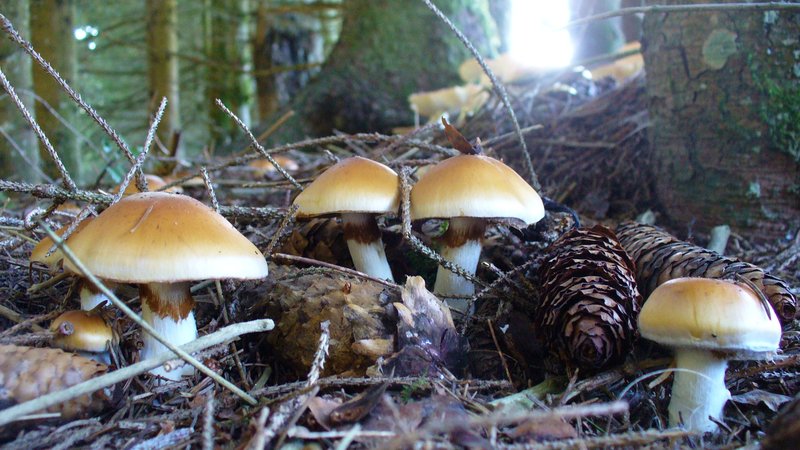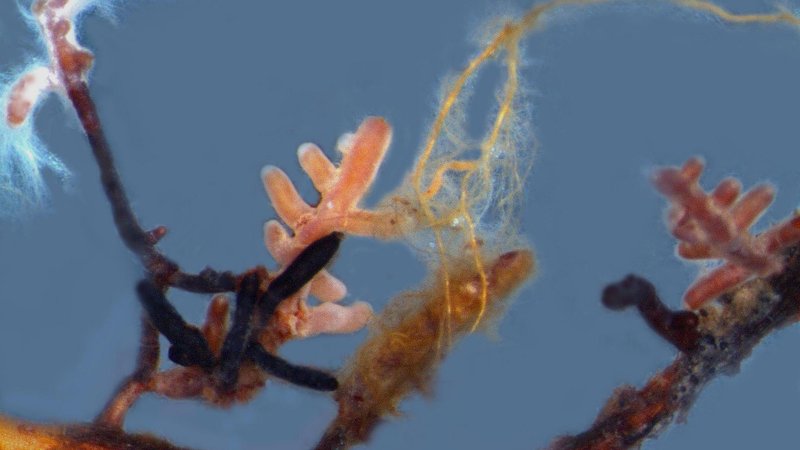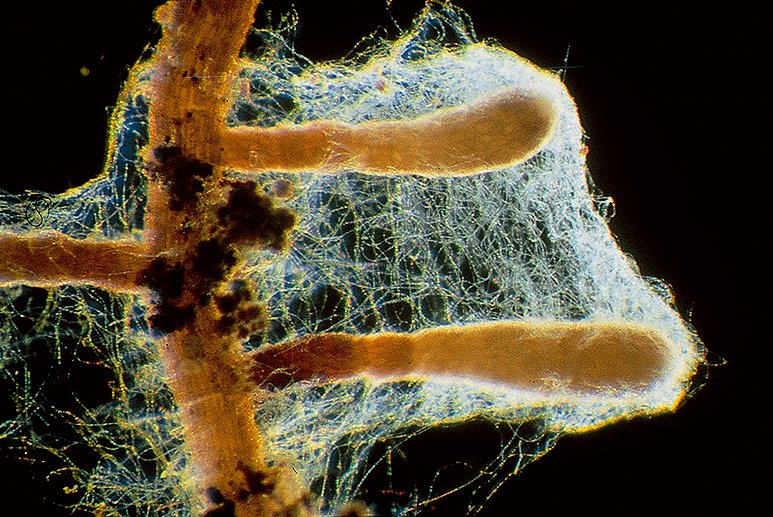So-called mycorrhizal fungi have co-evolved with plants for hundreds of millions of years and today live together in close relationships with their plant partners. Fungal species communities are very diverse (fig. 1 and 2): in a single handful of forest soil, hundreds if not thousands of different species are to be found. Exactly which species are present may differ from soil to soil and forest to forest.
There are two main forms of this partnership between fungus and plant: arbuscular mycorrhizal and ectomycorrhizal partnership. The latter is relevant in the forest. In the case of an ectomycorrhiza, the fungi live not within, but outside the plant’s roots. Their network (mycelia) of fungal threads (hyphae) wraps itself tightly around the plant’s finest roots, but does not penetrate the cells of its host’s roots as endomycorrhizas do. Both fungi and trees benefit from their close partnership, which is known as symbiosis. Unlike free-living fungi, which feed themselves, ectomycorrhizal fungi receive their energy almost exclusively from trees. In return, the fungi provide “their” trees among other things with nutrients such as phosphorus and nitrogen, or protect the trees from pathogens.
Until now, it has been unclear whether these differences have an impact on forest processes - natural regeneration, or tree growth, for example - because until recently, such processes have not been measured at the same time or in combination with assessments of the composition of fungal communities. This is because the necessary studies are time-consuming, complex, and expensive. Researchers at the ETH Zurich and the Swiss Federal Institute for Forest, Snow and Landscape Research WSL have nevertheless carried them out in collaboration with an international team. Some initial results of the relevant studies are now available. The results indicate that certain fungi can be excellent bio-indicators of tree growth, and also make clear just how important fungal conservation is for forest management.
Energy exchange between tree and fungus
The energy exchange in these symbioses is considerable: the plants pass on 5 to 40 percent of the sugar they produce during photosynthesis to their fungal partners. The nutrients that they receive in return from the fungi are essential for tree growth, and would remain inaccessible to them without the fungi. This raises the question of whether differences in the species composition of fungal communities can influence tree growth. Mycorrhizal fungi acquire nitrogen for example in different ways, and with different levels of energy expenditure.
Researchers at the ETH Zurich (technical university) and the Swiss Federal Institute for Forest, Snow and Landscape Research WSL set about answering this question. To do so, they compared the species composition of fungal communities at more than 130 forest sites in Europe with the tree growth rates at these sites (see info box).
And sure enough: there were huge differences in the tree growth rates – which correlated with the species composition of their fungal communities. Depending on the fungal species composition, there was a threefold variation in the growth rate of the trees, i.e., trees with the “ideal” fungal community grew three times faster than those associated with the “worst” fungal community. This effect was independent of other factors influencing tree growth, such as climate, forest stand characteristics or the nitrogen balance in the soil.
The effect of the fungal communities is similar in magnitude to other large-scale factors influencing tree growth in Europe, such as climate. It is thus all the more important that the effects of mycorrhizal fungal communities on tree growth (and mortality) and carbon storage in the soil are investigated further and in greater detail. This knowledge is essential for a better understanding of the mechanisms underpinning specific growth outcomes and terrestrial carbon sequestration under changing climatic conditions and thus for successful forestry management in times of climate change.
The authors’ research methods
For these studies, our research group determined and analysed the soil microbiome - all fungi, bacteria and archaea living in the soil - for 137 plots (fig. 3) using molecular methods. If fungi have many genes that show the presence of enzymes needed for the decomposition and thus accessibility of organic nitrogen compounds for the trees, this indicates that they are better able to use organic nitrogen than those species whose genome contains only a few of these genes.
We then linked this information to detailed forest inventory data from the European ICP forest network, which has been providing long-term information on forest growth and health since the 1980s.
Finally, we used all these data as a basis on which to model the effects of the characteristics of fungal communities on tree growth. The models allowed us to simultaneously take into account the effects of other known factors that influence tree growth in this forest network, and hence, to disentangle their influence from that of the fungi.
Functional correlations
Analyses of the fungal genes indicate that the difference may actually be due to the different strategies used by the mycorrhizal fungi to acquire nitrogen: it emerged that fungal communities in fast-growing forests have higher proportions of genes for acquiring nitrogen in its inorganic form. In communities linked to slow-growth forests, on the other hand, there are higher proportions of organic N cycling genes, i.e., genes that enable the fungus to use nitrogen that is bound in organic matter such as leaves. To use this nitrogen, the fungus first has to break the organic matter down into biologically available units - with a much greater energy input overall than is needed to obtain inorganic nitrogen.
Since the mycorrhizal fungi get their energy from trees, nitrogen from organic sources actually “costs” the trees more than when their fungal partners process inorganic nitrogen. The researchers believe that this could be one of the main reasons why inorganic N cycling fungi promote the growth of trees to a much greater extent than those that acquire complex and thus energetically costly organic forms of nitrogen. After all, the trees cannot use the sugar that they provide to their symbiotic partners for their own growth.
A high level of fungal biomass is costly for the tree
There is also a link between the way in which mycorrhizal fungi spread in the soil and tree growth. Some remain in close contact with the plant roots and do not extend far away from them. Others spread over short, medium or long distances. Some even develop extensive three-dimensional structures in the soil. One particular group of fungi - known as the “medium fringe exploration type” - permeates the soil very intensively and can make up huge proportions of the biomass in the soil. Their fungal threads fan out to form networks with many branches, also including thicker hyphae (rhizomorphs).
Fig. 4. The correlation between tree growth and the relative abundance of “medium fringe exploration type” ectomycorrhizal fungi. Source: Anthony et al. (2022, ISME)
It turned out that the higher the proportion of medium fringe exploration fungi in a mycorrhizal community, the lower the tree growth rate (fig. 4). This effect was particularly strong in coniferous forests, where these fungal species occur more frequently than in deciduous forests. It could also be related to the energy requirements of the fungi, since the relevant fungi required a lot of energy to form their huge systems. They get this energy from “their” trees – which cannot then invest the energy in their own growth.
This does not mean that these fungi slow down the growth of the trees, however, as the researchers are keen to emphasise: without their fungal partners, the trees could probably absorb far fewer nutrients - so they do still benefit from the symbiosis. Instead, the finding helps to explain why some mycorrhizal fungal species are less efficient in promoting tree growth than others.
Fungi as indicators of tree growth
Despite these indications, it is not yet conclusively clear whether the results really show causal relationships, or “just” correlations. Measures required to clarify this include field trials in which the composition of the mycorrhizal fungal communities in the soil is actively altered. Trials under controlled laboratory conditions are already under way. In these, sterilised soils are inoculated with different fungal communities and then planted with trees.
But even if the fungi are not themselves the reason for the different rates of growth, the findings can still be put to practical use. The fungi could at least be very good bio-indicators for tree growth, as further investigations have shown.
In the course of these, the researchers were in fact able to identify species that can serve as indicators for a particularly fast or in fact a rather slow rate of tree growth. Some occur in both coniferous and deciduous forests, others in just one forest type. The species Cenococcum geophilum occurs all over the world and is for example common in fast-growing coniferous forests. It is known to help trees cope with stressful conditions. However,C. geophilum does not have conspicuous fruiting bodies and is thus not a species that can be recognised “just like that” in woodland.
With other species, however, this is quite possible as they produce visible “mushrooms”. For example, the brittlegill (Russula ochroleuca), which is very common in fast-growing deciduous and coniferous forests (fig. 5) is particularly well adapted to the acquisition of inorganic nitrogen. The edible bay bolete (Imleria badia) is widespread in fast-growing coniferous forests (fig. 6).
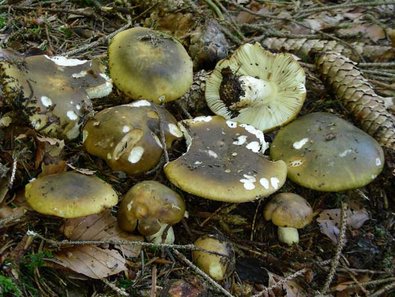
Fig. 5. The brittlegill (Russula ochroleuca) was the only indicator species for rapid tree growth in both deciduous and coniferous stands. Photo: Jörg Gilgen, swissfungi.wsl.ch.
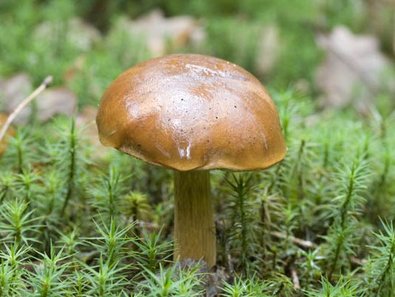
Fig. 6. The edible bay bolete (Imleria badia) is widespread in fast-growing coniferous forests. © Félicien Corbat, swissfungi.wsl.ch.
A list of such species could serve as a means of assessing the productivity of forests, based on the frequency of the relevant fungal fruiting bodies observed in the undergrowth simply during a walk through the stand.
Effects on forestry and nature conservation
Differences in ectomycorrhizal fungi communities also have numerous other effects on forest management and nature conservation. The most important thing is to show how essential it is to protect fungi. However, in most of Europe, efforts to protect fungi lag far behind efforts to protect other organisms such as plants or animals.
Forests in which particular fungi have been found to be associated with different tree growth rates should be monitored more intensively. The preservation of these forests and the fungal habitats within them is not just about preserving the fungi. The influence of the fungi on the trees helps to protect and promote forest functions such as timber production, or improve protection against natural hazards.
The new results also provide initial insights into the potential for active management of mycorrhizal fungal communities in forests in order to regulate tree growth: it may for example be possible to improve seedling performance by using suitable fungi from local forests to inoculate soils, or by using fungal species that have been associated with particularly rapid tree growth. This could ultimately lead to better results in planting operations. Studies are currently being carried out to investigate how some of these fungi (which can be cultivated) affect tree growth rates in the greenhouse.
Fig. 7. The effects of three species of ectomycorrhizal fungi (Amanita rubescens, Lactarius quietus and Piloderma olivaceum) on the growth of pine seedlings in the greenhouse. Trees inoculated with P. olivaceum - the species best able to take up organic nitrogen - grew fastest, especially at elevated levels of atmospheric CO2, when nitrogen availability is particularly limiting to tree growth. Source: Mike Dettwiler (Master thesis, 2021).
Fungal communities in the forest of the future
Currently, fungi that take up inorganic nitrogen accelerate tree growth more than those that use organic forms of nitrogen. And yet this “disadvantage” - in today’s terms – may well become an advantage in the future: Rising concentrations of carbon dioxide (CO2) in the atmosphere can theoretically accelerate tree growth, because trees need CO2 for photosynthesis. But to actually grow, they also need nitrogen. This in turn could one day become scarcer in its inorganic form in the soil, as demand for it increases due to the accelerated growth of the trees. If this happens, it could weaken the positive effect of carbon dioxide on growth or even stop it altogether.
Having said that, there is far more organic nitrogen in forest soils than inorganic nitrogen. The fungi that are currently associated with the slow growth of trees could therefore become important in the future, because they break down nitrogen in its organic form and then absorb it. They can still supply “their” trees with sufficient nitrogen, even if inorganic nitrogen becomes scarce as a result of the expected increase in photosynthesis in future. The trees associated with them could thus continue to benefit from the higher CO2 concentrations. That is at least what greenhouse experiments suggest: in experiments using the CO2 concentrations expected by the year 2100, those fungal species that best exploit organic nitrogen are those that best promote the growth of young tree seedlings (fig. 7).
Literature
Detailed methodological information and literature references can be found in the scientific publication on which this article is based:
- Anthony M.A., Crowther T.W., van der Linde S., Suz L.M., Bidartondo M.I., Cox F., … Averill C. (2022) Forest tree growth is linked to mycorrhizal fungal composition and function across Europe. ISME Journal, 16, 1327–1336.
– doi.org/10.1038/s41396-021-01159-7
– Download PDF
Translation: Tessa Feller

